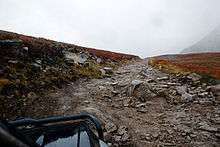Ukok Plateau



Ukok Plateau is a remote and pristine grasslands area located in the heart of southwestern Siberia, the Altai Mountains region of Russia near the borders with China, Kazakhstan and Mongolia. Pazyryk is the name given by modern scholars to an ancient people who lived in the Altai Mountains on this plateau who are associated with some spectacular archeological findings, including mummies found frozen in the permafrost. Many ancient Bronze Age tomb mounds have been found in the area and have been associated with the Pazyryk culture which closely resembled that of the legendary Scythian people to the west.[1] The term kurgen is in general usage to describe such log-barrow burials. Excavations of this site have continued to yield notable archaeological finds.[2] One famous finding is known as the Ice Maiden, excavated by Russian archaeologist Natalia Polosmak.[3][4] At least six tattooed mummies dating from the period ca. (c. 2600 BC - AD 402) have been recovered preserved by the permafrost in tombs at sites on the Ukok Plateau including Temrta III, Primorsky I, Ak-Alakha 3, Verkh-Kaldzhin 2, and the Pazyryk burial ground.[5]
The plateau is recognized as part of the UNESCO World Heritage Site entitled Golden Mountains of Altai as an important environmental treasure. It provides a habitat for many of the world's endangered species including one of its least studied predatory animals: the snow leopard. Other endangered species protected there include the argali mountain sheep, the steppe eagle, and the black stork.[6] Currently the Ukok Plateau is being threatened by plans for a gas pipeline between China and Russia. It is also being threatened by a proposal to build a road through it as well as overuse of the steppe by ranchers.[7]
The Ice Maiden and other archaeological finds were located just within a disputed strip of land between Russia and China.[8] The residents of the Altai Republic are demanding the return of the burial artifacts from their current location in Novosibirsk.[9]
Transport

The Ukok plateau is linked to the outside world by heavy-going dirt roads through the Ukok (Russia-Kazakhstan border), Ulan-Daba (Russia-Mongolia border), Teplyi kluch and Kalgutinsky passes. The Teplyi kluch pass is at an altitude of 2,907 metres (9,537 ft). One may get to these passes from Kosh-Agach village, which is easily reachable owing to a relatively improved M52 highway (the so-called Chuysky tract).
Southward, beyond Kosh-Agach, the way becomes impassable for common means of transport and passable only for off-road vehicles. However, even they could become stuck in swamp mud in the Kalguty river valley, especially after a sunny day when frozen soil begins thawing. For most of the year the passes are snow-covered and avalanche-prone. During the short summer season all the slopes are prone to solifluction.
Notes
- ↑ Bahn, Paul G. (2000). The Atlas of World Geology. New York: Checkmark Books. p. 128. ISBN 0-8160-4051-6.
- ↑ "Golden Mountains of Altai". UNESCO. Retrieved 2007-07-31.
- ↑ "Ice Mummies: Siberian Ice Maiden". PBS - NOVA. Retrieved 2007-07-31.
- ↑ "Prehistoric Art - Early Nomads of the Altaic Region". The Hermitage Museum. Retrieved 2007-07-31.
- ↑ Deter-Wolf, Aaron; Robitaille, Benoît; Krutak, Lars; Galliot, Sébastien (February 2016). "The World's Oldest Tattoos". Journal of Archaeological Science:Reports 5: 19–24. doi:10.1016/j.jasrep.2015.11.007.
- ↑ "Protect Snow Leopard Habitat / Siberia". forests.org. Archived from the original on 2007-09-27. Retrieved 2007-07-31.
- ↑ "Altai: Saving the Pearl of Siberia". Retrieved 2006-11-30.
- ↑ Leigh Fenly (December 8, 2004). "Archaeology News". Retrieved 2007-11-27.
- ↑ "Minor nationality of Russia demands the return of "Princess of Ukok"". Pravda. February 21, 2005. Retrieved 2007-11-27.
References
- S.I. Rudenko, Kul'tura naseleniia Gornogo Altaia v skifskoe vremia ("The Population of the High Altai in Scythian Times")(Moscow and Leningrad, 1953) translated as Frozen Tombs of Siberia: The Pazyryk Burials of Iron Age Horsemen, M.W. Thompson, tr. (University of California Press, Berkeley) 1970. ISBN 0-520-01395-6
External links
| Wikimedia Commons has media related to Ukok Plateau. |
- Photos of Ukok Plateau - Altai-Photo
- Greater Altai – Altai Krai, Republic of Altai, Tyva (Tuva), and Novosibirsk
- Gas pipeline route in south Siberia to be approved in August
- A collection at Novosibirsk State University site, including Pazyryk
- Life in Ukok Plateau photostory
Coordinates: 49°18′28″N 87°35′41″E / 49.3078°N 87.5947°E